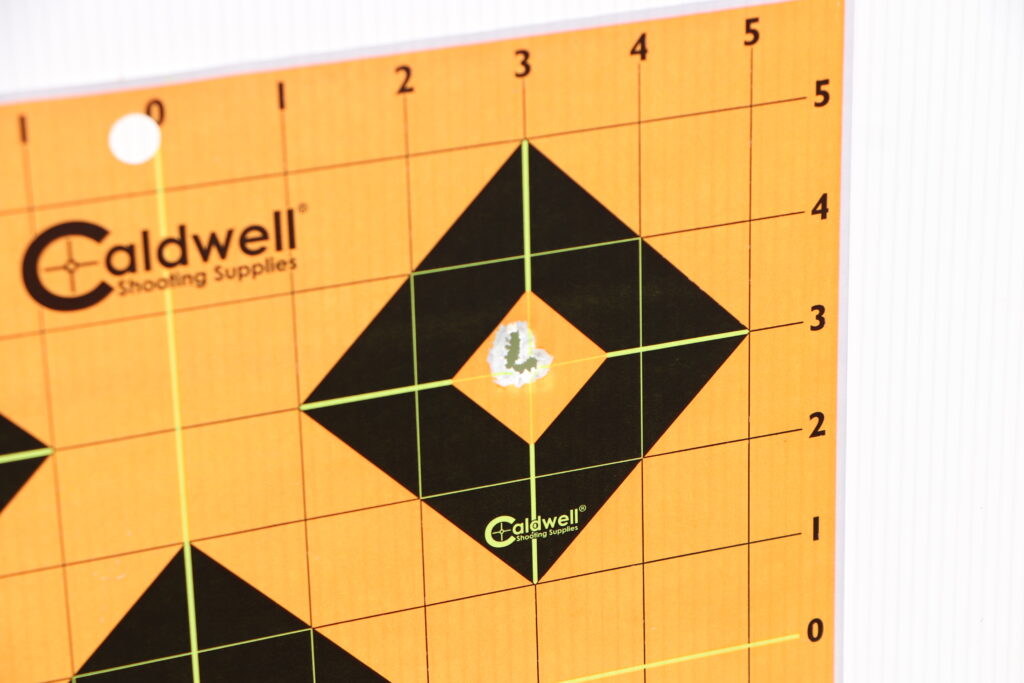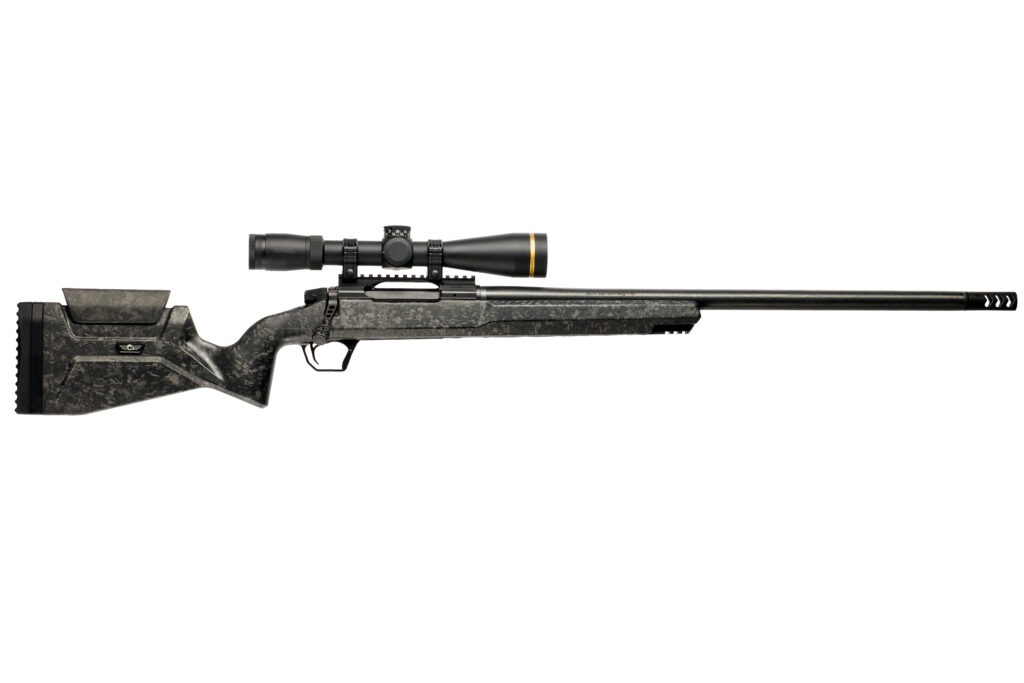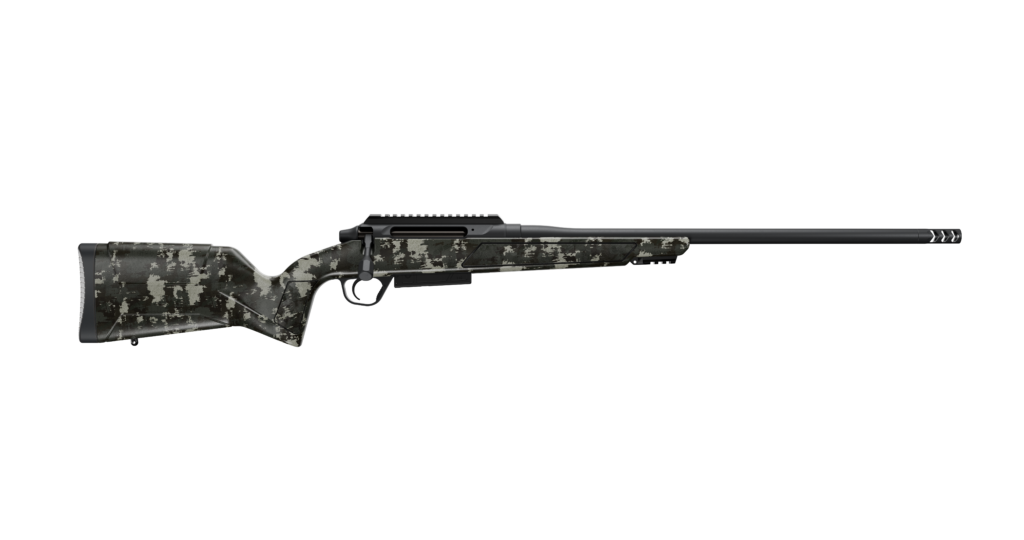Driving Tacks in Texas
Christensen Arms Delivers Innovation, High Performance With New Rifle Models
By Steve Comus, Editor-in-Chief
Originally published in the 2024 July/August Issue of Safari Magazine.
Christensen Arms is attacking the market with a vengeance, introducing interesting and exciting new rifle models as they continue to focus on performance.
Although Christensen Arms has come a long way since they were the first to introduce carbon-wrapped barrels nearly three decades ago, they remain true to their original commitment to high-tech and high-performance.
When a company’s culture is one of innovation, it can be a challenge to stay ahead of the industry consistently. But that’s just what Christensen Arms is doing.
All this became abundantly clear when a bunch of us gathered at the Guitar Ranch not far from Lubbock, Texas, to shoot some of the new models at long-range and longer-range targets with the help of instructors from Outdoor Solutions shooting school.
Targets were engaged from close all the way out to 1,000 yards, and some folks even took pokes at targets a mile away — and hit them now and then with the rifles chambered for the 6.5 Creedmoor.
To 1,000 yards, the 6.5 Creedmoor cartridge is quite credible. For example, with the new Christensen Arms Modern Carbon Rifle (MCR), I triggered a three-shot, five-inch group at 1,000 yards. That’s a half MOA delivered at distance, and yes, there was a wind that wasn’t all that steady, resulting in the three shots stringing horizontally.
After adjusting the cheek piece so my eye was aligned with the scope properly and zeroing the Zeiss Conquest V4 4-16×50 scope at 100 yards, I proceeded to engage targets at longer and longer distances, becoming familiar with the rifle, scope and ammo along the way. Bear in mind that on such outings, the first time we handle any of the equipment is when it’s time to blast.
The more I shot the MCR, the more I liked it. Trigger pull was crisp and clean, the bolt cycled smoothly and rounds fed from the magazine without a hitch.
In addition to the many features on this new model, it engendered a feeling of confidence, of being “solid” in the sense that everything was in the right place, made of the right stuff and functioned both intuitively and predictably.
It is important for any rifle rig to fit and handle in such a way as not to get in its own way, so to speak. When a rig is configured and adjusted correctly, it should help the shooter. Or, put another way, the shooter should not have to “fight” the rig to put the bullets where they are intended to go.
With all three of the rifle models I shot, the rifles, sights and ammo helped and never hindered accuracy. This was particularly true with the Ridgeline FFT. More about that later.
Quickly, it became apparent that not only could the targets be hit at the various distances, but that it didn’t take much to deliberately put shots at various places on the targets at those distances.
Spotting for me was one of the guys from Outdoor Solutions. These guys are great coaches, and instantly, I appreciated the way they knew how to communicate what they were seeing, along with suggestions of how to make the shots even better. A spotter’s ability to communicate effectively with the shooter is critical.
Hence, by the time I was ready to shoot the 1,000-yard target, we were clicking. The first shot hit the target at the very lower right corner, so I changed the sight picture slightly, about as much as I thought it should be, to put the next round vertically in the middle (at such moments in shooting in the wind, sight picture is paramount, because the sights already have been set properly and even a click or two at that distance can be a big change, and a click here or there can confound things if the wind changes even a tiny bit).
I overcompensated, and the second shot went near the upper right corner of the target. I did some mental calculations and decided to see how far to the left the sight picture had to go to put the round in the top middle of the target. We’re talking about splitting the visual difference of the thickness of the reticle feature for some of these shots.
That third shot hit in the upper left of the target, so I altered the sight picture just a tad to the right and a smidgen lower. When the next shot hit a little below and to the right of the previous shot, I had the proper sight picture figured out if I went still lower and a bit more to the right.
So, I sent a round downrange, and the spotter exclaimed that I had hit dead center. “Same hold, do it again,” I heard from the spotter as the reticle rested where I thought I had it on the previous shot. Bang. “Same hold, send another,” was the spotter’s reply.
“The last two bullets hit the same spot,” I heard from the spotter as I ejected the third consecutive shot’s empty case from the rifle. I got up from the bench to look through the spotting scope and figured I probably wasn’t going to improve the results, so I just said that I wanted to go to the target and see it close-up once the range was cold.
Sure enough, when I got to the target, I could see the shots leading up to the final three, and, yes, the last two shots did hit the same spot. I figured that the horizontal stringing that put the overlapped last two shots left of dead center was due to slight changes in the wind (or pilot error, take your pick).
Granted, I was likely just lucky to shoot such a group because, during my life, I have been more often lucky than good. But what the heck, I’ll take it and frankly the important part was that the group reflected the fact that the rifle, ammo and scope were doing their jobs. It was just a matter of me doing my job at the trigger.
Lots of things go into that kind of accuracy at range, and one fact is certain: If the rifle isn’t accurate in the first place, all the other factors, at best, merely match or degrade the overall performance.
The sights, ammo and shooter cannot improve on the inherent accuracy of the rifle. And an accurate rifle cannot realize its potential if the sights, ammo and shooter fail to perform properly.
Whether it was from the bench on the range at regular targets or from various field positions at animal-shaped targets into and across canyons, first shot kill-zone hits were routine with the MCR and Ridgeline FFT at all typical hunting shot distances and beyond.
Both the MCR and Ridgeline FFT were topped with Zeiss Conquest V4 4-16×50 scopes. Ammo was Federal’s 6.5 Creedmoor Gold Medal CenterStrike open tip match 140-grain load.
The Ridgeline FFT, with its more classic hunting style stock, was a true joy to shoot. It was credible as far as the MCR was, and it worked both smoothly and flawlessly. To my way of thinking, the Ridgeline FFT is a thoroughbred hunting rifle.
The ammo was amazingly consistent, and the scope performed flawlessly. In addition to crystal clear optics, scopes for the longer ranges need to have repeatable adjustment capability, and the Zeiss scope was amazingly consistent through the wide range of adjustments made repeatedly as shot distances went from 100 to 1,000 yards over the period of a couple days.
Whether it was dialing for the proper distance or using reticle marks to allow for wind, the Zeiss scopes made hitting the targets both easy and enjoyable.
Quickly, it became apparent that when using top-notch equipment like rifle, scope and ammo, the limiting factor is the shooter’s marksmanship abilities.
Instructors and spotters from Outdoor Solutions helped address any pilot errors, both on the range and in the field. This resulted in increasingly higher success rates under a wide variety of scenarios.
As riveting as the centerfire shooting was, the new Christensen Arms Modern Precision Rifle Rimfire quickly proved to be addicting. Talk about a fun gun!

The word Precision in its name is there for a reason — we shot overlapping bullet holes at 100 yards and had no trouble hitting to 200 yards. And that’s with the .22 long rifle. The ammo was the CCI Green Tag 40-grain load.
When it comes to small game hunting, there are many states and areas where rimfires can be used that do not allow centerfires. And, of course, rimfires are not nearly as expensive to shoot, so rimfires have a lot going for them.
The fascinating thing is that, as rifles and sights become more consistent, it is now possible to test more easily and precisely the performance of the ammunition they shoot. That’s right. Rifles now are accurate enough to take advantage of the consistency and quality of the ammunition they shoot or to show if the ammo is not up to snuff.
Bottom line: rimfires are now more serious equipment than ever before, and there have been many very serious rimfire rifles through the years. This is another example of how technology and advanced manufacturing abilities are resulting in better products for the consumer. It’s a win/win situation all the way.
Ammunition is also becoming more consistent, so the only real limiting factors anymore are the marksmanship abilities of the shooters themselves. That’s a great place to be because now serious and consistent practice is the only thing standing between the shooter’s dreams and the realities of precision shooting.
Following are some quick looks at Christensen Arms products this year:
Modern Carbon Rifle

Starting at 6.7 pounds, the MCR wears a Flash Forged Technology (FFT) carbon fiber stock with an adjustable push-button cheek riser, full-length M-LOK on the forearm, front and rear QD attachment points, adjustable length of pull via spacers and an integrated forward Picatinny rail section.
The Remington 700-style action is topped with and optic-ready 20-MOA Picatinny rail and features a skeletonized bolt handle with a carbon fiber bolt knob.
Fitted to the action is a free-floating, hand-lapped, button-rifled Christensen Arms aerograde carbon fiber barrel with a Match chamber and suppressor-ready (5/8×24 thread pitch) threaded muzzle equipped with a premium side-baffle brake.
It also features a detachable magazine, an ergonomically designed hybrid grip and crisp, adjustable TriggerTech trigger (3.5 lb. factory set: 2.5-5 lb. adjustability range).
Chamberings, barrel lengths and twist rates are:
6.5 Creedmoor – 22-inch barrel, 1:8 twist.
6.5 PRC – 22-inch barrel, 1:8 twist.
7mm PRC – 24-inch barrel, 1:8 twist.
.308 Win. – 22-inch barrel, 1:10 twist.
.300 Win. Mag. – 24-inch barrel, 1:10 twist.
.300 PRC – 24-inch barrel, 1:8 twist.
Modern Precision Rifle Rimfire

The Christensen Arms MPRR is a bolt action chassis rifle with carbon fiber tension barrel. It features a Remington 700-style trigger, lightweight billet aluminum chassis with folding stock, FFT carbon fiber handguard with M-LOK, adjustable FFT carbon fiber cheek piece and six QD flush-cup mounts.
The barrel is button rifled and precision lapped with match chamber and threaded muzzle (1/2×20). The bolt features dual extractors and dual opposing locking lugs.
The action has a 0-MOA optic rail, Remington compatible TriggerTech trigger, and it uses Ruger BX-1 magazines. The rifle also features V-block bedding and an AR-compatible grip.
The MPRR is available in three chamberings. Barrel lengths available for all three are 16, 18 and 20 inches. Chamberings and rifling twists are:
.22 LR – 1:16 twist.
.17 HMR – 1:9 twist.
.22 WMR – 1:14 twist.
Evoke

Also new this year from Christensen Arms is the Evoke suite of rifles, which represent a change from tradition for Christensen Arms in that they do not have carbon fiber-wrapped barrels.
Although there were no Evokes at the Texas shoot, there was plenty of information about them, including the fact that they will have six-lug bolts, which means a short bolt lift.
The Evoke is intended to provide a new entry point into the world of Christensen Arms rifles yet offers a host of features that promise to make it a truly credible hunting rifle anywhere in the world.
Sporting a 416R stainless steel #4 contour precision barrel with Cerakote finish, the Evoke is built around Christensen Arms’ proprietary precision action. They are suppressor-ready and include a premium RFR (Reduced Felt Recoil) muzzle brake.
The stock has a hybrid grip angle, and the Evoke sports a user adjustable TriggerTech trigger. Other features include a detachable box magazine, integrated Picatinny rail and swivel sling studs, as well as cheek riser adjustability.
Every Evoke rifle configuration features a sub-MOA guarantee and a limited lifetime warranty.
The Evoke is available in 11 chamberings: .243 Win., 6.5 Creedmoor, 6.5 PRC, .270 Win., 7mm Rem. Mag., 7mm PRC, .308 Win., .30-06 Springfield, .300 Win. Mag., .300 PRC and .350 Legend.
Ridgeline FFT

With a starting weight of 5.3 pounds, the Ridgeline FFT is a thoroughbred hunting rifle. It features a Christensen Arms precision machined receiver, TriggerTech trigger and standard 6-48 Remington 700 optics base.
It has an internal magazine with carbon fiber hinged floorplate and holds four standard cartridges or three magnum rounds. The Ridgeline FFT has a spiral fluted bolt, improved bolt release and enlarged ejection port, and features stainless steel bedding pillars.
The Ridgeline FFT is available in a host of chamberings, ranging from .243 Win. to .300 PRC.
Targets Vs. Game Animals
Familiarization outings like the one in this report are great for showing the capabilities of the equipment used. Long-range shooting is both enjoyable and rewarding.
However, there is a caveat, and that is that shots on game animals need to be limited to the competency level of the equipment and shooter combined. In other words, if every shot can hit the inanimate target at 500 yards, then a successful 300-yard or closer shot on game is virtually a certainty. Shoot straight and hunt forever.

